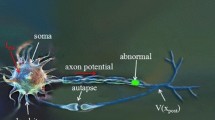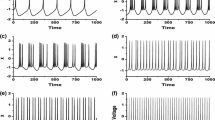Abstract
Responding to various stimuli, some neurons either remain resting or can fire several distinct patterns of action potentials, such as spiking, bursting, subthreshold oscillations, and chaotic firing. In particular, Wilson’s conductance-based neocortical neuron model, derived from the Hodgkin–Huxley model, is explored to understand underlying mechanisms of the firing patterns. Phase diagrams describing boundaries between the domains of different firing patterns are obtained via extensive numerical computations. The boundaries are further studied by standard instability analyses, which demonstrates that the chaotic neural firing could develop via period-doubling and/or period- adding cascades. Sequences of the firing patterns often observed in many neural experiments are also discussed in the phase diagram framework developed. Our results lay the groundwork for wider use of the model, especially for incorporating it into neural field modeling of the brain.
Similar content being viewed by others
References
Alligood KT, Sauer TD, Yorke JA (1997) Chaos, an introduction to dynamical systems. Springer, New York
Anderson MP, Mochizuki T, Xie J, Fischler W, Manger JP, Talley EM, Scammell TE, Tonegawa S (2005) Thalamic Cav3.1 T-type Ca2+ channel plays a crucial role in stabilizing sleep. Proc Natl Acad Sci USA 102: 1743–1748
Bezanilla F (2008) Ion channels: from conductance to structure. Neuron 60: 456–468
Chay TR (1985) Chaos in a three-variable model of an excitable cell. Physica D 15: 233–242
Chay TR, Rinzel J (1985) Bursting, beating, and chaos in an excitable membrane model. Biophys J 47: 357–366
Connor JA, Walter D, McKown R (1977) Neural repetitive firing: modifications of the Hodgkin–Huxley axon suggested by experimental results from Crustacean axons. Biophys J 18: 81–102
Deco G, Jirsa VK, Robinson PA, Breakspear M, Friston K (2008) The dynamic brain: from spiking neurons to neural masses and cortical fields. Public Libr Sci Comput Biol 4:e1000092
Doi S, Kumagai S (2005) Generation of very slow neural rhythms and chaos near the Hopf bifurcation in single neuron models. J Comput Neurosci 19: 325–356
Ermentrout GB (1994) Reduction of conductance-based models with slow synapses to neural nets. Neural Comput 6: 679–695
Ermentrout GB (1998a) Linearization of f–I curves by adaptation. Neural Comput 10: 1721–1729
Ermentrout GB (1998b) Neural networks as a spatio-temporal pattern-forming systems. Rep Prog Phys 61: 353–430
Ermentrout B, Pascal M, Gutkin B (2001) The effects of spike frequency adaptation and negative feedback on the synchronization of neural oscillators. Neural Comput 13: 1285–1310
Gerstner W, Kistler W (2002) Spiking neuron models: single neurons, populations, plasticity. Cambridge University Press, Cambridge
Guckenheimer J, Oliva R (2002) Chaos in the Hodgkin–Huxley model. SIAM J Appl Dyn Syst 1: 105–114
Hodgkin AL, Huxley AF (1952) A quantitative description of membrane current and its application to conduction and excitation in nerve. J Physiol 117: 500–544
Holden AV, Fan YS (1992) From simple to simple bursting oscillatory behaviour via chaos in the Rose–Hindemarsh model for neuronal activity. Chaos Soliton Fractals 2: 221–236
Izhikevich EM (2005) Which model to use for cortical spiking neurons. IEEE Trans Neural Netw 15: 1063–1070
Izhikevich EM (2007) Dynamical systems in neuroscience: the geometry of excitability and bursting. MIT, Gambridge
Izhikevich EM, Desai NS, Walcott EC, Hoppensteadt FC (2003) Bursts as a unit of neural information: selective communication via resonance. Trends Neurosci 26: 161–167
Lample I, Yarom Y (1997) Subthreshold oscillations and resonant behavior: two manifestations of the same mechanism. Neuroscience 78: 325–341
Markram H, Toledo-Rodrigurez M, Wang Y, Gupta A, Silberberg G, Wu C (2004) Interneurons of the neocortical inhibitory system. Nat Rev Neurosci 5: 793–807
McCormick DA, Bal T (1997) Sleep and arousal: thalamocortical mechanisms. Annu Rev Neurosci 20: 185–215
Naud R, Marcille N, Clopath C, Gerstner W (2008) Firing patterns in the adaptive exponential integrate-and-fire model. Biol Cybern 99: 335–347
Pedroarena C, Llinas R (1997) Dendritic calcium conductances generate high-frequency oscillation in thalamocortical neurons. Proc Natl Acad Sci USA 94: 724–728
Rabinovich MI, Abarbanel HDI (1998) The role of chaos in neural systems. Neuroscience 87: 5–14
Rabinovich MI, Varona P, Selverston AI, Abarbanel HDI (2006) Dynamical principles in neuroscience. Rev Mod Phys 78: 1213–1265
Rinzel JM (1985) Excitation dynamics: insights from simplified membrane models. Fed Proc 44: 2944–2946
Rinzel JM, Ermentrout GB (1989) Analysis of neuronal excitability. In: Koch C, Segev I (eds) Methods of Neuronal Modeling, MIT Press, Cambridge, MA
Robinson PA, Kim JW (2012) Spike, rate, field, and hybrid methods for treating neuronal dynamics and interactions. J Neurosci Methods 205: 283–294
Robinson PA, Wu H, Kim JW (2008) Neural rate equations for bursting dynamics derived from conductance-based equations. J Theor Biol 250: 663–672
Rose RM, Hindmarsh JL (1985) The assembly of ionic currents in a thalamic neuron I: the three-dimensional model. Proc R Soc Lond B 237: 267–288
Rubin J, Wechselberger M (2007) Giant squid-hidden canard: the 3D geometry of the Hodgkin–Huxley model. Biol Cybern 97: 5–32
Rubin J, Wechselberger M (2008) The selection of mixed-mode oscillations in a Hodgkin–Huxely model with multiple timescales. Chaos 18: 015105–015112
Shriki O, Hansel D, Sompolinsky H (2003) Rate models for conductance-based cortical neuronal networks. Neural Comput 15: 1809–1841
Staba RJ, Wilson CL, Fried I, Engel J (2002) Single neuron burst firing in the human hippocampus during sleep. Hippocampus 12: 724–734
Steriade M, Timofeev I, Grenier F (2001) Natural waking and sleep states: a view from inside neocortical neurons. J Neurophysiol 85: 1965–1985
Terman D (1991) Chaotic spikes arising from a model of bursting in excitable membranes. SIAM J Appl Math 51: 1418–1450
Touboul JD, Brette R (2008) Dynamics and birfurcations of the adaptive exponential integrate-and-fire model. Biol Cybern 99: 319–334
Touboul JD, Ermentrout GB (2011) Finite-size and correlation-induced effects in mean-field dynamics. J Comput Neurosci 31: 453–484
Wang XJ (1993) Genesis of bursting oscillations in the Hindmarsh–Rose model and homoclinicity to a chaotic saddle. Physica D 62: 263–274
Wilson HR (1999a) Simplified dynamics of human and mammalian neocortical neurons. J Theor Biol 200: 375–388
Wilson HR (1999b) Spikes, decisions, and actions. Oxford University Press, Oxford
Wu H, Robinson PA, Kim JW (2011) Firing responses of bursting neurons with delayed feedback. J Comput Neurosci 31: 61–71
Yang Z, Lu Q, Li L (2006) The genesis of period-adding bursting without bursting-chaos in the Chay model. Chaos Soliton Fractals 27: 689–697
Author information
Authors and Affiliations
Corresponding author
Rights and permissions
About this article
Cite this article
Qi, Y., Watts, A.L., Kim, J.W. et al. Firing patterns in a conductance-based neuron model: bifurcation, phase diagram, and chaos. Biol Cybern 107, 15–24 (2013). https://doi.org/10.1007/s00422-012-0520-8
Received:
Accepted:
Published:
Issue Date:
DOI: https://doi.org/10.1007/s00422-012-0520-8




